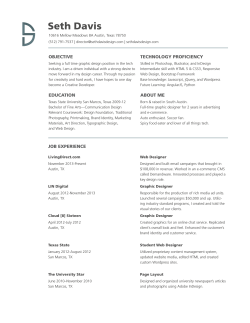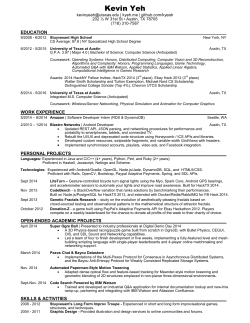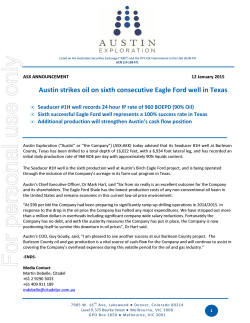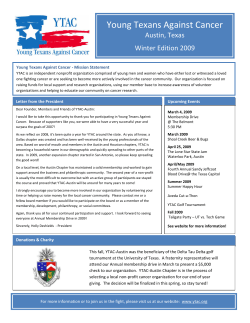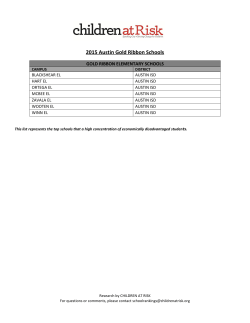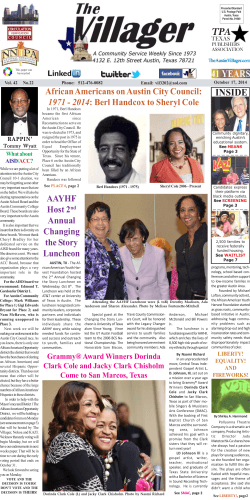
2015 JURY SELECTION FINALISTS
2015 JURY SELECTION FINALISTS Field Constructs Design Competition Announces Jury Selection Finalists Field Constructs Design Competition (FCDC) is pleased to announce the 2015 Jury Selection Finalists. The appointed jury reviewed and evaluated all eligible submissions, resulting in the selection of 18 top-ranked proposals. The selection highlights a variety of approaches to today’s design innovation and represents a breadth of material, technical, and social design solutions for engaging the competition brief. The diverse qualifications of the project teams capture cutting-edge work of emerging professionals and creative practices across multiple disciplines. Jurors noted an appreciation for the scale and ambition of the chosen proposals, the variety of material approaches, and the possibility for installations to marry a sense of discovery with surprise. FCDC attracted submissions from 4 continents, 9 countries, 14 states, and 35 cities. The finalist selection marks the conclusion of Phase One of the competition. The 2015 Jury Selection Finalists will be exhibited at The University of Texas at Austin in November 2015. FCDC would like to thank the 2015 jury: Virginia San Fratello of Rael San Fratello in Oakland, CA; Benjamin Ball of Ball-Nogues Studio in Los Angeles; Ingrid Spencer, executive director of AIA Austin; Jason Sowell, associate professor and program director of landscape architecture at The University of Texas at Austin School of Architecture; and Seattle-based artist John Grade. During Phase Two, the FCDC co-founders will review Jury Selection Finalists in order to identify 2015 FCDC Winners slated for realization. The selection—based on curatorial factors, funding, and feasibility—will be announced in July 2015. The winning projects will be constructed and open to the public at the Circle Acres Nature Preserve from November 14, 2015 to November 22, 2015 as part of a week-long event series, promoting design and community programming at the competition site, the Circle Acres Nature Preserve in Austin’s Montopolis neighborhood. 2015 Jury Selection Finalists 99 WHITE BALLOONS Invivia (Brad Cantrell, Allen Sayegh, Stefano Andreani, Craig Reschke, Ziyi Zhang) Cambridge, MA USA BLURRED BODIES Studio Roland Snooks (Roland Snooks, Cam Newnham, Sascha Bohnenberger) Melbourne, Australia CLOUDFILL Blake Smith, John Cunningham, Seth Brunner New York, NY USA COMMPOST Daniel Gillen, Colby Suter, Gustav Fagerstrom Beijing, China DIS-FIGURE Aptum Architecture (Julie Larsen, Roger Hubeli, Sean Morgan, Nathaniel Banks, Sai Lv) Syracuse, NY USA DUCK BLIND IN PLAIN SITE Jonathan Scelsa, John Paul Rysavy, Jennifer Birkeland, Isaac Stein, Nick Mitchell, Erin Wythoff Brooklyn, NY USA ENTOURAGE HA Architecture (Jamie Crawley, Dharmesh Patel, Charles Meyer), Manuel Gonzales Austin, TX / Lexington, KY USA FRINGE emerymcclure architecture (Michael A. McClure, Ursula Emery McClure), Kristi Cheramie, Sarah Young Lafayette, LA / Columbus, OH USA GLAM CAMO: FIELD PHANTASMS Studio Modo (Clay Odom) Austin, TX USA HYBROOT OTA+ (Kory Bieg) Austin, TX USA LAS PIÑATAS Goujon Design (David Goujon) Austin, TX USA MEAT CHURCH FIELD KITCHEN Jordan Bartelt, Scrap Marshall Los Angeles, CA USA REPLACEMENT Abe Drechsler, Allison Hale, Amanda Maderic, Claire Eddleman, Kristina Olivent Austin, TX USA S(P)OIL CORES The OAK CLIFF Dirty 4 (Isaac Cohen, Chris Kiahtipes, Gwen McGinn, Maggie Winter) Dallas, TX USA TEXTEX Banned Practice (Sarah Cowles, Maritt Vaessin) Columbus, OH USA TRANSECTUAL HEALING Lauren Fasic, Clayton Holmes, James Morgan, Brendan Wittstruck Austin, TX USA WASTE CRACK Ludovico Centis, Nerea Feliz, Logan Wagner Milan, Italy / Austin, TX USA YELLOWFIELDS Cruz Mendez Austin, TX USA 2015 Jury Selection Finalists are illustrated on the following pages with edited excerpts from the authors’ abstracts. The projects are ordered alphabetically by proposal title. Sponsors Ecology Action of Texas, Texas Architect Magazine, Texas Society of Architects, Pentagram, AIA Austin, Austin Foundation for Architecture, Bustler, Archinect. 99 WHITE BALLOONS Invivia (Brad Cantrell, Allen Sayegh, Stefano Andreani, Craig Reschke, Ziyi Zhang) Cambridge, MA USA 99 White Ballons is activated by a series of microphones and proximity sensors as well as 396 LED lights that float high above the ground with the balloons. When a person, or deer, or other wildlife moves closer to the proximity sensor a stepper motor slowly draws the balloon cable closer to the ground at that anchor tower, as they move away the balloon cable is released. Similarly sounds picked up by the microphones at each anchor tower increase the intensity of the LEDs in waves outward from that tower. The towers themselves are equipped with LEDs that respond to small temperature variations, illuminating the microclimates at work between the ground and the tree canopy. Each tower and its relationship to floating ring illustrates the small differences in each of the preserve’s three landscape types through temperature, ambient sound, and movement. BLURRED BODIES Studio Roland Snooks (Roland Snooks, Cam Newnham, Sascha Bohnenberger) Melbourne, Australia Blurred Bodies hovers between the natural and the artificial. It shifts between camouflaging with its environment and reveling in its alienation. The project has been designed through behavioral-based algorithms in which a turbulent surface emerges from a swarm of agentBodies. This process imbues the project with a natural or swarm like character, which is balanced against the industrial nature of its fabrication process and tectonic detailing. While sculptural in nature, the project is fundamentally an architectural prototype. It is part of an ongoing exploration into the synthesis of surface, structure, and ornament through complex systems. Blurred Bodies is an experiment that is intended to be inhabited—or at least navigated. It sits somewhere between an installation and a pavilion, with ambitions of being proto-architectural. CLOUDFILL Blake Smith, John Cunningham, Seth Brunner New York, NY USA Cloudfill is made up of three site-adjusted installations, one to address each of the three distinct natural biomes comprising the ten-acre brownfield site: forest, wetland, and grassland, each created using the same flexible construction module: plastic bags filled with plastic bottles. In an effort to proliferate the educational mission of the Ecology Action of Texas, each piece references an environmental issue affecting its respective biome: deforestation, the Pacific Trash Vortex, strip mining, and landfills. The project proposes a vision of the potential site transformation and the reuse of post-consumer materials in the construction of architectural space. With strikingly contradictory objects in a serene context, Cloudfill highlights the inherent uncanny-ness of the site’s many manipulations, calling into question the true meaning of ‘nature’ and ‘landscape.’ COMMPOST Daniel Gillen, Colby Suter, Gustav Fagerstrom Beijing, China COMMPOST is an educational tool informing the public of the techniques and benefits of composting organic food waste. Guests of COMMPOST will be able to engage in the practice of composting and see the results of their efforts over the lifespan of the installation. Given its temporary site, COMMPOST is familiar in its iconicity yet playfully foreign. Computational design allows for the complex form to be catalogued and described with a minimal kit of parts. Components are nested for material ecology, with overage chipped and used as composting ingredients. Similar to an Ikea or Lego set, COMMPOST comes with a step-by-step assembly manual in addition to COMMPOST’s uncommon zero waste disassembly guide. DIS-FIGURE Aptum Architecture (Julie Larsen, Roger Hubeli, Sean Morgan, Nathaniel Banks, Sai Lv) Syracuse, NY USA Where artifice meets nature, dis-FIGURE privileges process over form by re-configuring the ‘figure’ not through a particular style but with a specific method of making. The pavilion is designed to structurally maneuver around specific trees and debris on the site. The complex form is generated from 1.5-inch-by-one-inch overlapping wood members that inherently become self-supporting. Layers of thin biodegradable latex sheets ‘tattoo’ and wrap the underbelly of the structure to create an illuminated surface that glows and changes the image of the pavilion throughout the day. Through the intertwining of skeleton and mutilated skin, a digitally enhanced structure and its biodegradable latex ornamentation dis-figures the form and, in turn, alludes to a new reading of ‘form meets nature’ as the grotesque, the uncanny, and the unexpected. DUCK BLIND IN PLAIN SITE Jonathan A. Scelsa, John Paul Rysavy, Jennifer Birkeland, Isaac Stein, Nick Mitchell, Erin Wythoff Brooklyn, NY USA Duck Blind in Plain Site is born out of a desire for contextual double-readings, wherein architectural form “doubly functions” to exist in its own system while simultaneously within the system of its site. Duck Blind’s exterior, shrouded in camouflage, seeks to hide within its pastoral setting, while its interior attempts to subvert the exterior’s camouflage with apertures and thresholds showcasing high chromatic interior claddings. Duck Blind’s contextual tension is heightened through its material composition: a double-sided brick construction featuring high-contrast post-consumer recycled materials as cladding on the interior, while the exterior features grass harvested from the seasonal cycle of local ecologies. The goal is to create an object expressing a visual tension in relation to its context, wherein the object oscillates from being one with and against nature. ENTOURAGE HA Architecture (Jamie Crawley, Dharmesh Patel, Charles Meyer), Manuel Gonzales Austin, TX / Lexington, KY USA Entourage explores the presence and presentation of place making—highlighting the role of fiction. Viewers are encouraged to discover Entourage’s seeming discordance within the Circle Acres Nature Preserve. Through a smart phone app, visitors can read each individual story of the figure in front of them and view a rendered architectural reality not yet realized. They also can view a map highlighting each individual Entourage, discovering stereotypes of this place. The form follows fiction and each viewer interacting with Entourage provides the bridge between realities presented. FRINGE emerymcclure architecture (Michael A. McClure, Ursula Emery McClure), Kristi Cheramie, Sarah Young Lafayette, LA / Columbus, OH USA FRINGE is an exhibit of exposure: exposure of waste, exposure of reclamation, exposure to the elements. On average, an American family uses 1,500 plastic grocery bags a year. Of this amount, almost all of it ends up in the trash or loose in the environment, and the bags do not break down. Austin is the first city in Texas to attempt to mitigate this waste issue by banning plastic bags within the city limits. Fringe serves as a tribute to the city’s efforts and those of Ecology Action of Texas. It is also a symbol of the environmental impact of this issue. Mimicking the field and the plethora of plastic bags that lie beneath, Fringe rents the ground asunder to expose. From afar, the visitor will see the field rise. As they approach, the ground will open up to them. From inside, they will look back out through the bags at what the waste has become: the field. GLAM CAMO: Field Phantasms Studio Modo (Clay Odom) Austin, TX USA Glam Camo: Field Phantasms engages a thread of research that investigates the relationship between form, material, and ephemeral effects productions as both contextual links and contextual production mechanisms. Using notions of the field condition as both a tool of generating graphic pattern and as a formal, tectonic strategy, the project is designed to generate a range of atmospheric, lighting, and formal effects. Fundamentally, the proposal desires to critically engage in the notion of field constructs. Here we understand field constructs to imply questions regarding nature and landscape or more precisely the natural and the artificial to generate a proposal that is situated to both stand-out from the ‘natural’ while also exhibiting tendencies toward concealment and linkage with it. HYBROOT OTA+ (Kory Bieg) Austin, TX USA Hybroot reflects the balance between urban fabric and natural landscape indicative of the project site. The form, color, and material of Hybroot mimic the surrounding grasses and tree canopy, while the fabrication, assembly, and surface patterning evoke a more synthetic sensibility. At first glance the two are inseparable, but on closer inspection, one notices artificial formal compositions, unnatural pixilation of colors, and the artifact of the CNC-lathing process left as surface texture. The sheen and reflectivity of each paint color varies between the natural and plastic. It is both root and robot. Las Piñatas Goujon Design (David Goujon) Austin, TX USA Las Piñatas tells the story of Austin’s growth through the life cycle of the piñata. In early 2015, a local, family-owned piñata store was razed to the ground by a pair of transplanted property developers in the city’s rapidly gentrifying East Austin neighborhoods. The low-income and predominantly Hispanic neighborhood of Montopolis will inevitably become another friction point between the development of a ‘new’ Austin and the preservation of ‘old’ Austin. Our objective is to preempt this debate and engage the community in a project that ends not in destruction, but in rebirth. The centerpiece of the installation will be two digitally-fabricated oversized piñatas in the shape of the iconic Mexican burro crowned by a dense canopy of superhero piñatas. MEAT CHURCH FIELD KITCHEN Jordan Bartelt, Scrap Marshall Los Angeles, CA USA The premise of the solitary church in the Texas landscape and Austin’s rich culinary heritage is re-composed and redefined as a gateway, catalyst, and social generator. Here, on the remains of a reclaimed landfill site, the bells toll for hungry souls as plumes of sweet smelling smoke bring visitors and locals alike to a place of relaxation, community, and feasting. The Field Kitchen will be designed and constructed in Los Angeles and brought to site as a series of pre-fabricated parts, ready for easy assembly and installation. The Meat Church is agnostic, contextual, opportunistic, and optimistic. It takes the form of two parts: a physical prefabricated grill and smoker and a ‘menu’ formed and prepared by BBQ experts. REPLACEMENT Abe Drechsler, Allison Hale, Amanda Maderic, Claire Eddleman, Kristina Olivent Austin, TX USA Within the wetland at the Circle Acres Nature Preserve, a black willow stand is reaching the end of its lifecycle. What will succeed it is unknown. Replacement interlaces willow saplings with steel rebar to call attention to temporal change within man-made and natural systems. The carefully situated strands of steel and willow will serve as a rigorous formal metric to gauge changes in the landscape and the Montopolis neighborhood. The rebar will be removed after one cycle of seasons, while the cuttings will continue the story of growth and decay indefinitely. As the stand matures, the established pattern will gradually undo itself. S(p)oil Cores The OAK CLIFF Dirty 4 (Isaac Cohen, Chris Kiahtipes, Gwen McGinn, Maggie Winter) Dallas, TX USA S(p)oil Cores allows us to exaggerate and interpret the many layered natural and human horizons of the Circle Acres Nature Preserve. Through an investigation of the site’s past, this simple installation of curated soil cores enables visitors to imagine a new future for the site, one of thoughtful creation and understanding of the ground we walk on. S(p)oil Cores is a 24-foot-by-24-foot-square grid made of fabricated 16 “soil cores,” illustrations of the whimsy, toxicity, historic, contemporary, and future — offered at a variety of scales. A narrative of exploitation and regeneration unfolds, one that applies to numerous illegal dumps across Texas, helping us to see below the surface. TEXTEX Banned Practice (Sarah Cowles, Maritt Vaessin) Columbus, OH USA TEXTEX is an ecological armature constructed from commercially available environmental restoration materials: geo-textiles, erosion control mats, hydroseed mixes, coir logs, and live stakes of native Texas plant species. By amplifying, hacking, and foregrounding the aesthetic qualities of ecological restoration materials, TEXTEX draws attention to how living systems perform in tandem with man-made materials to restore ecological health and alter site aesthetics. It is experienced as a garden. Each prototype is a locus of visual intensity, composition, and handiwork within the existing landscape matrix. The materials and species palette is specific to the conditions of each site: low and wet, sloped and shaded, sunny and dry. The siting of these prototypes brings attention to the range of disturbed conditions within the Circle Acres Nature Preserve. TRANSECTUAL HEALING Lauren Fasic, Clayton Holmes, James Morgan, Brendan Wittstruck Austin, TX USA Transectual Healing is a spatial intervention emerging from and spanning across the Circle Acres Nature Preserve. It intends to enrich user engagement by creating an armature telling the story of the site by exposing its layers and history, revealing the ebb and flow of water and seasons, embracing decay and providing spaces and surfaces on which multiple media and the site itself can perform. The installation is built of three interwoven parts. A bamboo armature transects the site and references the past site topography as it has changed with human intervention. Within it, an assembly of construction debris reveals the hidden layer beneath the ground. Finally, a west-facing screen collects shadows and provides an opportunity for digital media and social connectivity. WASTE CRACK Ludovico Centis, Nerea Feliz, Logan Wagner Milan, Italy / Austin, TX USA Waste Crack is a crafted fissure conformed by rammed earth walls made from the local sand. The vividly colored stripes at the base of the cavity introduce a further narrative: They remind us of the site’s past and the hidden substances we may find underground. In a society where the perception of a successful life is often associated with accumulation, waste becomes a shameful thing. Waste Crack introduces a pause, both spatially and visually, as an interruption in the continuous surface of the grass field. But first and foremost, it invites us to take a pause, as it provides an opportunity to stop our movement, our gaze, and our thoughts to inquire on what the crack itself reveals. YELLOWFIELDS Cruz Mendez Austin, TX USA YellowFields engages the natural surroundings of the site and draws attention to a part of Austin that has long been socio-economically neglected. The structure’s framework mirrors the winding boundary of the forest surrounding the open field. The unique use of fabric is dual purposed: to provide shade and to create an interactive experience with the structure. The project is meant to attract pedestrians and cyclists to a reclaimed oasis within the city and to stimulate reflection on the man-made construct within the beauty of the natural site on which it rests.
© Copyright 2026
